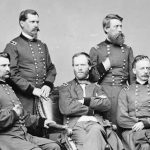 Weird Stuff
Weird Stuff  Weird Stuff
Weird Stuff  Animals
Animals 10 Inspiring Tales of Horses Being Human
 Mysteries
Mysteries Top 10 Haunting Facts About the Ghost Ship MV Alta
 History
History 10 Surprising Stories About the Texas Rangers
 Humans
Humans 10 Philosophers Who Were Driven Mad by Their Own Theories
 Miscellaneous
Miscellaneous 10 Video-Game-Worthy Weapons and Armors from History
 Weird Stuff
Weird Stuff 10 Psychics Who Accurately Predicted Wartime Events
 The Arts
The Arts 10 Pieces of Art Inspired by a Broken Heart
 Health
Health 10 Science Fiction-Sounding New Medical Treatments
 History
History 10 Surprising Facts About the Father of Submarine Warfare
 Weird Stuff
Weird Stuff 10 Times Real Laws Were Based on Bizarre Hypotheticals
 Animals
Animals 10 Inspiring Tales of Horses Being Human
 Mysteries
Mysteries Top 10 Haunting Facts About the Ghost Ship MV Alta
Who's Behind Listverse?

Jamie Frater
Head Editor
Jamie founded Listverse due to an insatiable desire to share fascinating, obscure, and bizarre facts. He has been a guest speaker on numerous national radio and television stations and is a five time published author.
More About Us History
History 10 Surprising Stories About the Texas Rangers
 Humans
Humans 10 Philosophers Who Were Driven Mad by Their Own Theories
 Miscellaneous
Miscellaneous 10 Video-Game-Worthy Weapons and Armors from History
 Weird Stuff
Weird Stuff 10 Psychics Who Accurately Predicted Wartime Events
 The Arts
The Arts 10 Pieces of Art Inspired by a Broken Heart
 Health
Health 10 Science Fiction-Sounding New Medical Treatments
 History
History 10 Surprising Facts About the Father of Submarine Warfare
10 Surprising Things That Were Designed to Stop Evil Behavior
Throughout history, people have banned all kinds of things that were claimed to cause evil or unwanted behavior. However, taking things away from people is not the only tool that has been used to combat these things. Others have taken an additive approach and created something which they hoped would help achieve the same result.
A surprising number of beloved products that are still around today either started out this way or have been marketed for such reasons during the course of their history. These range from board games and breakfast cereals to sweet treats and soft drinks, but their moral purpose often gets forgotten with time. What follows are 10 of the most surprising things that were created to stop evil and unwanted behavior.
Related: Top 10 Products Which Aren’t Used for Their Original Purpose
10 Chutes and Ladders: Teaching Morality to Children
The board game giant Milton Bradley launched Chutes and Ladders in the U.S. in 1943, but some might know that the game is called Snakes and Ladders in the UK. The reason for this discrepancy goes back to the game’s origins in India, where it was not merely the amusing luck-based race to the final square that it is today. In fact, it was used to impart moral values to Indian children, and each snake head on the board symbolized a vice for the kids to avoid.
These vices could be things like bad company, false knowledge, and ego. The tail of each snake told the children about the effect of each vice so that they learned what would happen if they engaged in it. The final square represented liberation for players who were lucky enough to avoid vices and keep on a virtuous path.
Despite its simplicity, the game’s importance in India was often reflected in the names it was known by. These included Gyan Chaupar, meaning Game of Knowledge. It was after the British introduced the game back home in 1892 that it became known as Snakes and Ladders, and its focus shifted from moral education to entertainment.[1]
9 Monopoly: Exposing Capitalism’s Evils
It is unlikely that any fortune-hungry family members would be as furious about Monopoly as its creator were she alive to see what it has become. When Elizabeth Magie patented her “Landlord’s Game” in 1904, she intended for it to be played with two sets of rules. The first Magie called the “Monopolist” rules. These encouraged players to selfishly acquire properties and demand rent from the other players.
However, this version of the game was meant to be contrasted with her “Prosperity” rules, which saw players taxed when they bought a new property. The tax money was shared between the players, and everybody won when the person who had the least money at the start doubled their share. The idea was for people to use both sets of rules so they could compare the two systems and their outcomes.
Magie wanted this to expose the problems of the current system of capitalist property ownership, and this made the game popular among left-wing academics. However, the Parker brothers (after purchasing the “rights” from Charles Darrow, who made his own version of Magie’s game in 1932) would later buy the patent, drop the “Prosperity” rules, and rebrand the game as Monopoly.[2]
8 Roller Coasters: Leading Adults Away from Tempation
In the late 1800s, nobody could have known that the American inventor LaMarcus Thompson would dream up the roller coaster. Until then, his most notable invention was a sewing machine for making seamless stockings. However, as a devout Christian, he was disturbed by the popularity of brothels and saloons among his countrymen. But rather than deny their need for amusement, he sought to create a wholesome alternative that was just as fun.
Thompson learned about a coal mining town in Pennsylvania where people would pay a dollar to ride the coal train because the track had a steep drop where the train reached speeds of up to 60 mph (96.6. km/h). Inspired by this, he sold his hosiery business and used the money to design and build his own exciting track on Coney Island.
Although it could only go 6 mph (9.7 km/h), it was a huge success. It kept people away from Coney Island’s seedier establishments while earning Thompson eye-watering amounts of money and kick-starting the global amusement park industry.[3]
7 Treadmills: Making Prisoners Work
Millions of people might use them today, but it is safe to say that treadmills are not a type of amusement. And this is by design. While early treadmills were also meant to stop bad behavior, they did so by punishing people instead of distracting them.
They were invented by William Cubitt in 1818 for use in English prisons, where up to 24 prisoners at a time would spend hours on them. They quickly became popular (at least with wardens) in prisons around the country, and they were mainly used to make prisoners suffer, although the mill often did grind corn or pump water. By 1822, they were being installed in American prisons, too.
However, as they became more prevalent, their problems became more apparent. People realized that the treadmill provided prisoners with no knowledge that could help them when they were released. Not only were treadmills not useful, but they were dangerous, too. One English prisoner a week died using them. They had mostly disappeared from English prisons by the end of the century, and in the U.S., they barely lasted five years. They would return in a 1913 U.S. patent as a “training-machine.”[4]
6 Graham Crackers: Driving Those Dirty Thoughts Out of Your Mind
Graham crackers are named after their inventor, Sylvester Graham, and they were the product of two of his interests: diet and helping people control their sexual urges. If the latter seems strange, it is worth noting that he was a Presbyterian minister. He believed that food could benefit not only people’s physical health but their spiritual health, too. For example, by avoiding spices, sugar, and chemicals in their diet, people could avoid thinking about sinful topics like sex.
Graham created his namesake crackers to give people an easy snack to eat that met his strict dietary requirements, which also included being vegetarian. As such, the original graham crackers did not contain sugar and spices like modern versions do. They were bland and apparently a little nutty, but somehow they caught on.
However, their popularity might have had something to do with the cult-like following Graham had amassed. He was outspoken when it came to his views on food and spirituality, and this earned him thousands of devoted followers. When he offered them a food that would help save their souls, few would say no.[5]
5 Kellogg’s Corn Flakes: Keeping Urges to Self-Pleasure at Bay
Graham crackers were not the only bland anaphrodisiac snack to come to market in the 19th century. Another religious inventor came up with his own highly successful alternative, and he called them “Corn Flakes.” That inventor was Dr. John Harvey Kellogg, a devout Seventh-day Adventist whose notable inventions up to that point had been a granola cereal and a yogurt enema.
When it came to food and sex, he held similar opinions to Graham, if not even stronger. While he also thought that strongly flavored foods and meat increased sexual urges and that bland foods could quell them, he was so opposed to sex that he never even consummated his own marriage. He thought sex was physically and spiritually awful, but what he called “self-pollution” was even worse.
According to Kellogg, masturbation could lead to epilepsy, palpitations, and several more health conditions. Corn flakes were one of several cereals he invented, which he thought would help people manage their desires, and they were also the last. After a large marketing campaign helped by his brother Will, they were on their way to becoming the breakfast staple that they are today.[6]
4 Kellogg’s Other Contribution: Making Meat Meatless
Corn flakes and other cereals were not the only foods made by the Kelloggs, and reducing people’s sexual urges was not always their main goal. Around the beginning of the 20th century, John Harvey Kellogg was asked by the U.S. government to help find some protein-packed alternatives to meat. They were worried about meat becoming scarce and expensive because of the country’s growing population and the “wasteful economics” of animal farms.
As a vegetarian, Kellogg was happy to help and became an early innovator in the field of meat substitutes. He came up with many nut-based mixtures that were meant to mimic meat, such as protose. They did not exactly taste like meat, but several sold widely thanks to a growing trend toward vegetarianism in the U.S. at the time.
As well as limiting lust, Kellogg claimed his vegetarian “meats” could help stop violent urges. As an example of how these were caused by meat, he was known to tell a story about a wolf that was said to only turn aggressive after being allowed to eat meat.[7]
3 Candy Canes: Keeping Children Quiet in Church
This next food is also vegetarian, but it came along well before Graham and Kellogg, although nobody claims that it is healthy (or a meat substitute, for that matter). It is the candy cane, and this crooked Christmas treat is still going strong today, with as many as 1.76 billion being made in the U.S. each year. They are thought to have come from Germany, specifically Cologne Cathedral, during the frosty festive season of 1670.
The story goes that the cathedral’s choirmaster handed out sugar sticks to the young choristers to keep them quiet when they were not singing. Because it was Christmas, and perhaps because some church seniors did not think it was right to eat sweet treats in church, the choirmaster bent one end of the sticks around so that they resembled the crooks carried by shepherds in the Nativity story.
However, others have suggested that the hooks were made so that candy canes could be hung from trees. One thing that is almost certain, though, is that they were white. The red stripes would not be added until the turn of the 20th century.[8]
2 Coca-Cola: Offering a Wine Alternative
There is a certain irony in a “temperance drink” that contains cocaine as a key ingredient, but that can only be appreciated in retrospect. Back in the 1880s, presidents, royals, and even the pope were fans of cocaine beverages. Their drink of choice, however, was not Coca-Cola but “Vin Mariani.” This was wine infused with cocaine and sold as a tonic. It promised to nourish and strengthen those who drank it, and it was even advertised as a helpful beverage for “sickly children.”
In 1884, a chemist in Atlanta began selling his own cocaine wine as an alternative. He called it “Pemberton’s French Wine Coca” after himself. But a year later, the people of Atlanta voted in favor of Prohibition, forcing John Pemberton to come up with a new formula without any alcohol. He named the result Coca-Cola and sold it as the “Temperance Drink” and an “intellectual beverage.”
Although Pemberton started making his French Wine Coca again after Atlanta’s ban on alcohol ended two years later, it was his fizzy alcohol-free formula that really took off.[9]
1 Machine Guns: Preventing Deaths during Wars
With the creation of nuclear weapons in the 20th century came the concept of mutually assured destruction. It posits that should one world power attack another with a nuclear weapon, the victim would respond with an equally devastating attack or worse so that both end up destroyed. In theory, this means nobody will use them. However, the idea that possessing powerful weapons will deter conflict is not new. And, worryingly, the last time, it had the opposite effect entirely.
It started when Dr. Richard Gatling patented his hand-cranked machine gun in 1861. The misguided inventor thought what he had created would be so effective at killing that it would incentivize leaders to keep the peace. Just knowing that one’s enemies had Gatling guns ought to provide a good enough reason not to go to war, or at least not to commit many people to it.
Others made Gatling’s invention even more reliable and deadly, which was good if his theory was correct. However, he was proven extremely wrong when the First World War broke out. Machine guns on both sides contributed to death and destruction on a scale the world had never seen.[10]








